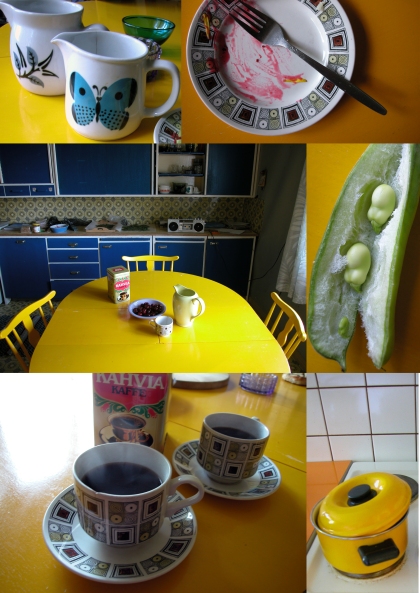Filed under: autumn seasonal food, Cooking, Salad | Tags: beetroot, black currant, bread spread, dolma, fava bean, grape leaf, mint, sesame
“Hippies are the dolphins of our race, playful, resilient, social, fetished by some, dismissed by others, ” says Chelsea Cain in her book The Hippie Handbook. She was raised in a hippie commune in the 70’s. I was reminded her words last weekend when I was asked to do a cafe for a hippie party, which was held at a yoga school in Helsinki.
I was a hippie myself for many years, and not without a reason! However much there can be bad jokes made of hippies, I think there is still a very important lesson that can be learned from them. Hippies see life as endlessly enjoyable, filled with creativity, beauty and meaningful encounters with other human and nonhuman beings. Of course, also the mainstream western society is generally very pleasure – oriented, but I think the difference with the hippie culture lies in the fact that the pleasure hippies seek is not destructive towards other living things, and generally doesn’t have a high price, to the environment or moneywise. How delicious is organic, vegan food, how pleasurable is a footmassage given by a friend, how much fun can be a drum and a guitar, how nice to spend a summer in a teepee, how delightful to learn new acrobatic tricks… It is so easy to forget the simple delights of communal living, when you struggle for your daily earnings in this society. In the hippie world, there is always enough time, and the greatest achievement of a person is to be present here and now.
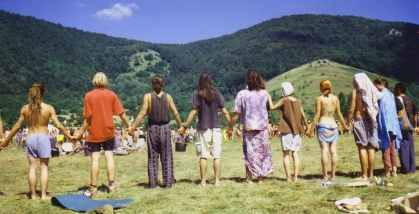
So this weekend at the hippie party I noticed we, who had met at some hippie gathering or other a few years ago, had all grown up, and perhaps matured too. There weren’t that many people at the party, and I think everybody had already seen enough life not to be pretentious about being a hippie. So people were laughing when the meditation was supposed to begin, did some really silly barefoot dancing and joked about the Natha – cult instead of a spiritual panel discussion (“hey girls, are you going to the Natha party afterwards? Watch out for the guru!”). Of course there were candles, a big mandala on the wall, some sandalwood incence and soft cushions. DJ Indigo played and we reminisced a little: somebody had decided to start a tribe, another one had been suspicious about hippies but then gone to a gathering and totally become one, third one had caused a major jealousy attack in a Peruvian boyfriend by acting like any hippie girl at a wedding party. Oh sweet crazy youth, I guess it shall never return. Luckily enough, I think I still have my dreadlocks with all the beads and colourful felt hidden off in some cupboard, so if I want to become a hippie again, I can just sew them back on…
I had made some proper hippie food for the party: local, cheap and colourful, and not too fancy. The menu included a platter with a stuffed grape leaf roll, some favabean – blackcurrant hoummus, sesame – marinated beetroots, minty coleslaw and raw chili – apple chutney, with a piece of sourdough rye bread.
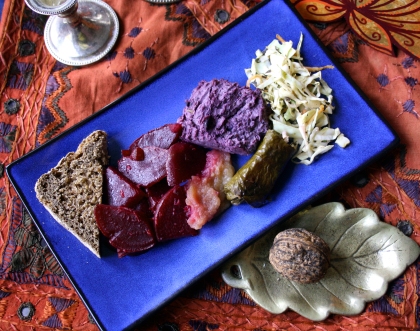
Finnish Hoummus
This is my local version of the Arabic classic – I know the ingredients sound weird but surprisingly they work really well together, and the paste actually tastes like hoummus! The purple colour is nice as well (to my taste..)
5 dl cooked favabeans
1 dl black currants
3 cloves of garlic
1 – 2 dl canola oil
salt
Soak the beans overnight and cook for an hour or until they are tender. Drain off the cooking water, add the rest of the ingredients and make into a paste with a blender.
Minty Coleslaw
The mint was somehow still alive in my garden, even if it has been below freezing many nights. This is a cheap and simple vegan coleslaw. You can make it with egg – free mayo too.
a couple of carrots
1 dl sesame seeds, toasted
a handful of mint leaves
1/2 dl lemon juice
1 dl olive oil
salt
Slice the cabbage really thin, preferably with a cheese slicer. Then pound it in order to make it more juicy, grate the carrot, chop the mint, toast the seeds and mix everything. The coleslaw is much better if you let it wait a few hours in the fridge.
Simple Dolmas
This is not how dolmas (stuffed grape leaves) are made in Greece, but if you aren’t a Greek grandmother with five dutiful daughters to help you, this might be the way you want to make them, since this is much faster and easier.
about 50 pieces
50 preserved grape leaves
6 dl brown rice, or preferably spelt or barley if you live in Finland
9 dl water for cooking
3 tsp salt
1 dl tomato paste
1 red onion, finely chopped
2 tsp spice mix that includes dill, chili, coriander leaf and mint (if you have fresh herbs at hand it’s much better)
2 dl olive oil
a packet of preserved grape leaf rolls
Boil the grain and allow it to cool. The dolmas are easier to roll if you boil the grain until it’s quite mushy. Then mix in the rest of the ingredients of the filling, and roll the dolmas. Basically you do the rolling so that you put a couple of teaspoons of filling at widest part of the grape leaf,then fold over the sides and roll the leaf into a tight roll. The problem with the preserved grape leaves is that they often are too small and have a lot of holes, but then you’ll just need discard those and use the bigger ones. Put the ready rolled dolmas on a oven dish, drizzle with olive oil and bake them in the oven in 200ºC for about 20 minutes, or until they have turned darkish in colour.
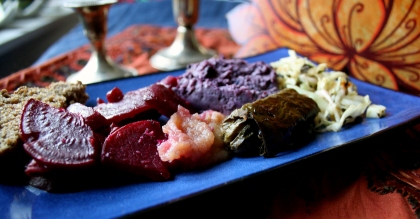
Om Shantih Shantih Shantih!
Filed under: Cooking, summer seasonal food | Tags: agrarian revolution, beetroot, black currant, herb oil, horse radish, mangold, parsley, salad dressing, summer food
In the States these so called 100 mile menus seem to be the new fad in restaurants. Basically it means that the ingredients for the menu are grown within a hundred miles. Also, in London there is a restaurant, which sells food that originates within the subway network of London. This menu that I’m going to write about, is not a 100 mile dinner, but a 15 meter lunch, since most of the ingredients were from a garden patch just 15 metres away.

I think that ideally we all should live like this, with lunches and dinners that are really picked just 15 metres away from the doorstep, and not bought from supermarkets. The commercial farming systems that produce the majority of our food at the moment are killing the planet, draining the water resources, turning independent farmers into slaves of the system, and suffocating natural ecosystems. We need a new agriculture. Monocultures must go.There aren’t many good alternatives, though. We are far too many people to be fed with grace, and some destruction of natural ecosystems is inevident in order to produce enough food for all.
But it’s not hopeless! There are things to do! You should all do it! Decentralization is the way to go with the production of food and energy. Small, intensive farming systems can produce amazing amounts of calories, if they are closely integrated in the everyday lives of people. Eat local, crop mob, depave, guerilla garden! Learn and teach permaculture, make a transition town initiative in your hometown, get an allotment garden, eat the seasonal food, and support your local organic farmers. And most important of all, do not despise what older people have to tell you, since many of them have the skills and knowledge from a life that was much more self – sufficient than our current lifestyle.
Recently me and my cousin made a trip to this old farmhouse, where our dads grew up. These days no one lives there, and that whole part of the countryside is full of empty houses, since the people have found their living in cities. There is a strange, almost haunted feeling in these places, with the rosty old farm machines in the barns and the empty gravel roads, once so busy.
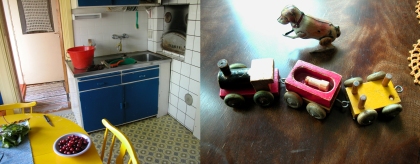
But anyhow, we both felt very peaceful and happy there, among the ghosts of our grandparents. The garden was also abundant, since my uncle and aunt had been tending it every now and then. Among the chickweed we found horse radish, potatoes, swedes, onions, carrots, beetroot, broad beans, mangold, salad, parsley, garlic and dill, and a monstrously big bush of lovage. And of course lots of black and red currants, which were the aim of our trip. This is some of the simple summer food we made.

Beetroot with Horse Radish
4 beetroots
a 3×3 cm piece of horse radish, peeled
1/2 dl extra virgin olive oil
salt to taste
water for cooking
First I sliced the beets thinly, and boiled them and the finely grated horse radish in a shallow amount of water until done, about 20 minutes. Then I drained off the water and added the oil and some salt. If you like more horse radish, you can grate some more and add at this stage for a stronger aroma. This dish can also be made into a bread spread, by using a hand held blender.
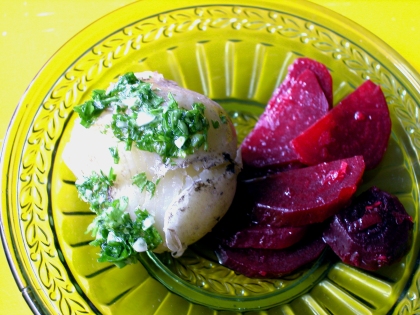
Herb Oil with Parsley to Go with New Potatoes
2 dl extra virgin oil (olive, canola etc)
1 dl finely chopped parsley
1 clove garlic
salt
This is such a simple thing, the ingredients are simply combined. It so delicious when made of fresh parsley. It is very nice together with new potatoes.
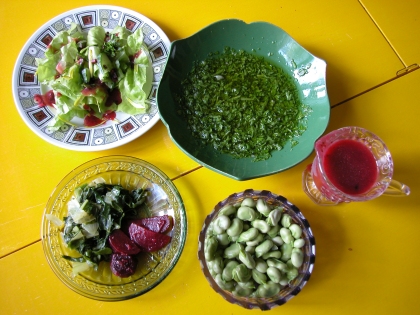
Salad Dressing with Black Currant
2,5 dl black currants
2/3 dl extra virgin oil
sugar
salt
The black currants should be ground through a sieve, in order to get rid of the peels. The resulting black currant mush is then mixed with oil, salt and sugar. It depends a bit how sweet you’d like to have it, you don’t necessarily need much sugar if you like it with a bit of a tang. We had it with some lettuce combined with a bit of mangold and marigold petals.
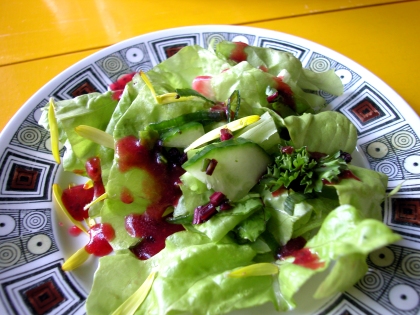
Mangold Stir Fry
10 mangold leaves
1 onion
3 cloves of garlic
1 tsp jeera
1 tsp ground coriander
1/2 tsp turmeric
a pinch of chillipowder
salt
oil for frying
The mangold leaves were first roughly chopped, as well as the onion and garlic. Then we fried the onion, garlic and the spices on a frying pan, and then tossed in the mangold, just for a minute or so.
